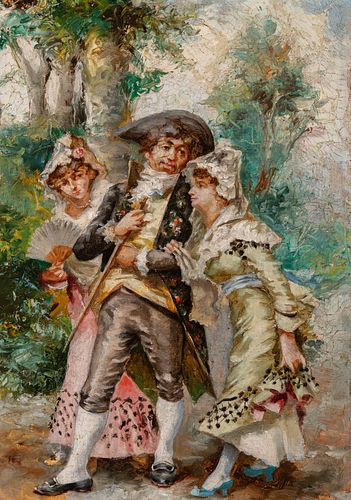Spanish school; XIX century. "Escena galante". Oil on canvas.
Lot 27
About Seller
Setdart Auction House
Carrer Aragó 346
Barcelona
Spain
Setdart Subastas was born in 2004 and is currently the first online art auction in Spain with solidity, prestige and reliability guaranteed by our more than 60,000 users. Setdart has a young, dynamic and enterprising team ready to successfully manage the purchase and sale of art works through custom...Read more
Estimate:
EUR€1,200 - EUR€1,500
$1,290.32 - $1,612.90
Absentee vs Live bid
Two ways to bid:
- Leave a max absentee bid and the platform will bid on your behalf up to your maximum bid during the live auction.
- Bid live during the auction and your bids will be submitted real-time to the auctioneer.
Bid Increments
| Price | Bid Increment |
|---|---|
| EUR€0 | EUR€10 |
| EUR€200 | EUR€25 |
| EUR€500 | EUR€50 |
| EUR€1,000 | EUR€100 |
| EUR€3,000 | EUR€200 |
| EUR€5,000 | EUR€500 |
| EUR€10,000 | EUR€1,000 |
| EUR€20,000 | EUR€2,000 |
| EUR€50,000 | EUR€5,000 |
About Auction
By Setdart Auction House
Nov 10, 2021
Set Reminder
2021-11-10 08:00:00
2021-11-10 08:00:00
America/New_York
Bidsquare
Bidsquare : 19th & 20th Century paintings and Decorative Arts
https://www.bidsquare.com/auctions/setdart-auction-house/19th-20th-century-paintings-and-decorative-arts-7800
Setdart Auction House sofia@setdart.com
Setdart Auction House sofia@setdart.com
- Lot Description
Spanish school; XIX century. "Escena galante". Oil on canvas. Presents period frame. Measurements: 35.5 x 23 cm; 58 x 43 cm (frame). Arranged in a profuse forest, three characters occupy the center of the composition. A man accompanied by two women who seem to overwhelm him, as they rush at him, a situation with which the man seems to be pleased. He directs his gaze towards one of the ladies, thus establishing his interest in her with respect to the other, who is slightly displaced both by the attention of the gentleman and by the composition chosen by the author. As for the aesthetics of the work, it stands out for the use of a quick brushstroke, although based on the drawing, especially in the conception of the characters. In the case of the landscape, the author has opted for a looser technique, which results in an atmospheric scene where the landscape is blurred. The scene is worked with great attention to detail, a strong descriptive spirit and a special care of the play of light and the qualities of the fabrics, following the masters of that century. This type of scenes, with a gallant and hedonistic theme, cheerful and colorful, worked with a precious and descriptive workmanship, were frequent during the second half of the 19th century, within the context of historicism. They belong to the genre called "de casacones" in Spain, and "tableautin" in France, characterized by works inspired by an idealized past, frequently from the 17th and 18th centuries, normally of small or medium format and destined to an eminently bourgeois clientele. One of the first examples of this genre was "Il Contino", by Mariano Fortuny, dated 1861 and kept in the National Art Museum of Catalonia. It is worth mentioning that Clemente Pujol achieved recognition through his orientalist paintings, however, during the first stage of his training he worked delicately in the tableutin genre.
- Shipping Info
-
In-house shipping available. Please inquire at admin@setdart.com.
-
- Buyer's Premium



 EUR
EUR CAD
CAD AUD
AUD GBP
GBP MXN
MXN HKD
HKD CNY
CNY MYR
MYR SEK
SEK SGD
SGD CHF
CHF THB
THB














